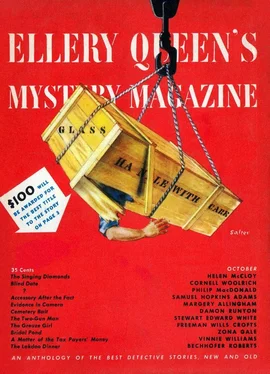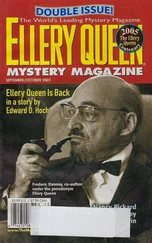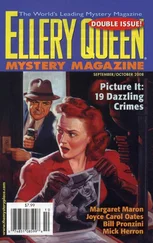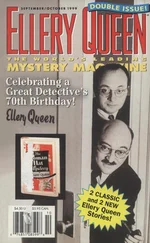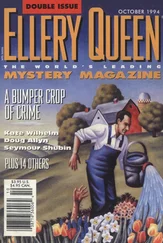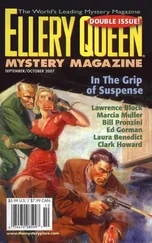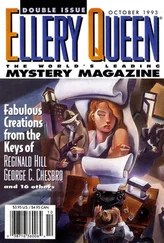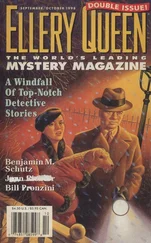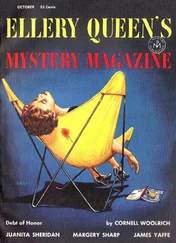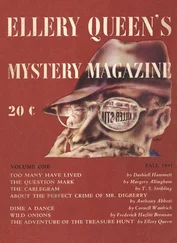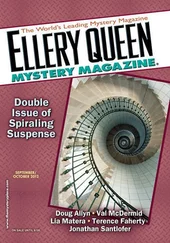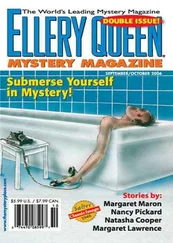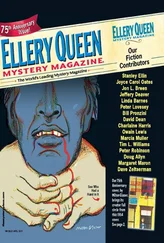Марджери Аллингем - Ellery Queen’s Mystery Magazine. Vol. 14, No. 71, October 1949
Здесь есть возможность читать онлайн «Марджери Аллингем - Ellery Queen’s Mystery Magazine. Vol. 14, No. 71, October 1949» весь текст электронной книги совершенно бесплатно (целиком полную версию без сокращений). В некоторых случаях можно слушать аудио, скачать через торрент в формате fb2 и присутствует краткое содержание. Город: New York, Год выпуска: 1949, Издательство: The American Mercury, Жанр: Классический детектив, на английском языке. Описание произведения, (предисловие) а так же отзывы посетителей доступны на портале библиотеки ЛибКат.
- Название:Ellery Queen’s Mystery Magazine. Vol. 14, No. 71, October 1949
- Автор:
- Издательство:The American Mercury
- Жанр:
- Год:1949
- Город:New York
- ISBN:нет данных
- Рейтинг книги:5 / 5. Голосов: 1
-
Избранное:Добавить в избранное
- Отзывы:
-
Ваша оценка:
- 100
- 1
- 2
- 3
- 4
- 5
Ellery Queen’s Mystery Magazine. Vol. 14, No. 71, October 1949: краткое содержание, описание и аннотация
Предлагаем к чтению аннотацию, описание, краткое содержание или предисловие (зависит от того, что написал сам автор книги «Ellery Queen’s Mystery Magazine. Vol. 14, No. 71, October 1949»). Если вы не нашли необходимую информацию о книге — напишите в комментариях, мы постараемся отыскать её.
Ellery Queen’s Mystery Magazine. Vol. 14, No. 71, October 1949 — читать онлайн бесплатно полную книгу (весь текст) целиком
Ниже представлен текст книги, разбитый по страницам. Система сохранения места последней прочитанной страницы, позволяет с удобством читать онлайн бесплатно книгу «Ellery Queen’s Mystery Magazine. Vol. 14, No. 71, October 1949», без необходимости каждый раз заново искать на чём Вы остановились. Поставьте закладку, и сможете в любой момент перейти на страницу, на которой закончили чтение.
Интервал:
Закладка:
“What roof?”
“This roof and any other roof contiguous.”
“Look, Aunt Minnie,” I said. “Babe Ruth himself couldn’t reach out between those bars and flip a knife five stories up onto a roof.”
“You’d better do as Aunt Minnie says,” my wife told me.
There’s a lot of rubbish on tenement roofs, but I found the knife, two buildings away back of a chimney. Anyway, I found a knife and a fish knife at that. Of course, there wasn’t a chance of fingerprints after it had been out in all that weather. I brought it back to Aunt Minnie.
“Find anything else?”
“I wasn’t looking for anything else.”
“No fishbones? No string? No brains!” said Aunt Minnie.
So I went back and brought in the lot. “Who put ’em there and why?” I asked.
“In the jargon of your district attorney, the accessory after the fact.”
“Oh, yeah? How?”
“Why, I suppose the murderer passed ’em out through the window.”
“Easy, like that! And how did he reach the window? Jump up eighteen feet from the courtyard and hang to the bars? Or scrounge his way across that ledge?”
“Funnier than ever,” said Aunt Minnie, “but not too smart. The ledge.”
“How could any man navigate a six-inch ledge?” Miriam asked.
“He couldn’t. A cat could. Many’s the time I’ve watched that ugly tom make it on his way to old Gommer’s window.”
“Wait a minute!” I said. “Are you telling us that a tomcat would carry away a knife and hide it on a roof?”
“If it was fixed up right, he would.”
Then I began to get it, but I didn’t like it. “How am I going to put that up to the D. A.?” I asked.
“I wouldn’t,” she advised.
“So the murderer not only gets out but collects his legacy, does he? That kind of gripes me, Aunt Minnie.”
“Well, I wouldn’t be so sure of his collecting,” Aunt Minnie said. “You didn’t know that I once taught drawing, did you?”
She wouldn’t explain that crack until Peter Finney’s death. He had received a large envelope in his morning mail and collapsed in the hallway when he opened it. On recovering, he went to the drug store for medicine, but bought rat poison instead.
Aunt Minnie looked pretty solemn when she got the news. “Perhaps it’s just as well,” she said, “though I didn’t foresee quite that result.”
“What was in your letter, Aunt Minnie?” my wife asked.
“It wasn’t a letter. It was a freehand sketch of a cat crawling on a ledge with a fish bound around with string in his mouth, and a knife handle sticking out beyond the fish.”
Which goes to prove, my wife says, that women know more than men about a lot of things, including logic.
Maybe so.
The Two-Gun Man{ Copyright , 1907, by Doubleday & Co., Inc. Copyright, 1935, by Stewart Edward White }
by Stewart Edward White
What two forms of entertainment fiction are most typically American? Species born and bred in, indigenous to, the American mind and the American soil. One might say, culturally American. Surely the detective story is one — the modern detective story was conceived and formulated by an American, Edgar Allan Poe; and even more surely, the Western story is another, although we have no idea which American writer was the first to see the enormous fictional possibilities of cowboys and Indians, of the fast trigger, fast horses, and slow drawl.
So when a story combines Western characters, background, and lingo with crime-story plot and detective-story technique, that story can be called All-American in the deepest sense of the word — as well as surefire in its appeal.
Here is such a story — and by one of the “greats” among Western-story writers. “The Two-Gun Man” by Stewart Edward White comes from his classic book, ARIZONA NIGHTS (1907), which may sound only vaguely familiar to the youngsters of today — with their Hopalong Cassidy and Lone Ranger — but which is full of red-blooded nostalgia for those youngsters’ fathers and uncles. The clean, invigorating, outdoor quality that thrilled nearly half a century ago is still magically present in “the topaz and violet and saffron and amethyst and mauve and lilac ” of the Chiricahuas, and in “the magnificent,flaming, changing, beautiful, dreadful desert of the Arizona plains.”
Buck Johnson was American born, but with a black beard and a dignity of manner that had earned him the title of Señor. He had drifted into southeastern Arizona in the days of Cochise and Victorio and Geronimo. He had persisted, and so in time had come to control the water — and hence the grazing — of nearly all the Soda Springs Valley. His troubles were many, and his difficulties great. There were the ordinary problems of lean and dry years. There were also the extraordinary problems of devastating Apaches, rivals for early and ill-defined range rights — and cattle rustlers.
Señor Buck Johnson was a man of capacity, courage, directness of method, and perseverance. Especially the latter. Therefore he had survived to see the Apaches subdued, the range rights adjusted, his cattle increased to thousands, grazing the area of a principality. Now, all the energy and fire of his frontiersman’s nature he had turned to wiping out the third uncertainty of an uncertain business. He found it a task of some magnitude.
For Señor Buck Johnson lived just north of that terra incognita filled with the mystery of a double chance of death, from man or the flaming desert, known as the Mexican border. There, by natural gravitation, gathered all the desperate characters of three States and two republics. He who rode into it took good care that no one should ride behind him, lived warily, slept light, and breathed deep when once he had again sighted the familiar peaks of Cochise’s Stronghold. No one professed knowledge of those who dwelt therein. They moved, mysterious as the desert illusions that compassed them about. As you rode, the ranges of mountains visibly changed form, the monstrous, snaky, sea-like growths of the cactus clutched at your stirrup, mock lakes sparkled and dissolved in the middle distance, the sun beat hot and merciless, the powdered dry alkali beat hotly and mercilessly back — and strange, grim men, swarthy, bearded, heavily armed, with red-rimmed unshifting eyes, rode silently out of the mists of illusion to look on you steadily, and then to ride silently back into the desert haze. They might be only the herders of the gaunt cattle, or again they might belong to the Lost Legion that peopled the country. All you could know was that of the men who entered, few returned.
Directly north of this unknown land you encountered parallel fences running across the country. They enclosed nothing, but offered a check to the cattle drifting toward the clutch of the renegades, and an obstacle to swift, dashing forays.
Of cattle rustling there are various forms. The boldest consists quite simply of running off a bunch of stock, hustling it over the Mexican line, and there selling it to some of the big Sonora ranch owners. Generally this sort means war. Also, there are subtler means, grading in skill from the rebranding through a wet blanket, through the crafty refashioning of a brand, to the various methods of separating the cow from her unbranded calf. In the course of his task Señor Buck Johnson would have to do with them all, but at present he existed in a state of warfare, fighting an enemy who stole as the Indians used to steal.
Already he had fought two pitched battles, and had won them both. His cattle increased, and he became rich. Nevertheless, he knew that constantly his resources were being drained. Time and again he and his new Texas foreman, Jed Parker, had followed the trail of a stampeded bunch of twenty or thirty, followed it on down through the Soda Springs Valley to the cut drift fences, there to abandon it. For, as yet, an armed force would be needed to penetrate the borderland. Once he and his men had experienced the glory of a night pursuit. Then, at the drift fences, he had fought one of his battles. But it was impossible adequately to patrol all parts of a range bigger than some Eastern States.
Читать дальшеИнтервал:
Закладка:
Похожие книги на «Ellery Queen’s Mystery Magazine. Vol. 14, No. 71, October 1949»
Представляем Вашему вниманию похожие книги на «Ellery Queen’s Mystery Magazine. Vol. 14, No. 71, October 1949» списком для выбора. Мы отобрали схожую по названию и смыслу литературу в надежде предоставить читателям больше вариантов отыскать новые, интересные, ещё непрочитанные произведения.
Обсуждение, отзывы о книге «Ellery Queen’s Mystery Magazine. Vol. 14, No. 71, October 1949» и просто собственные мнения читателей. Оставьте ваши комментарии, напишите, что Вы думаете о произведении, его смысле или главных героях. Укажите что конкретно понравилось, а что нет, и почему Вы так считаете.
